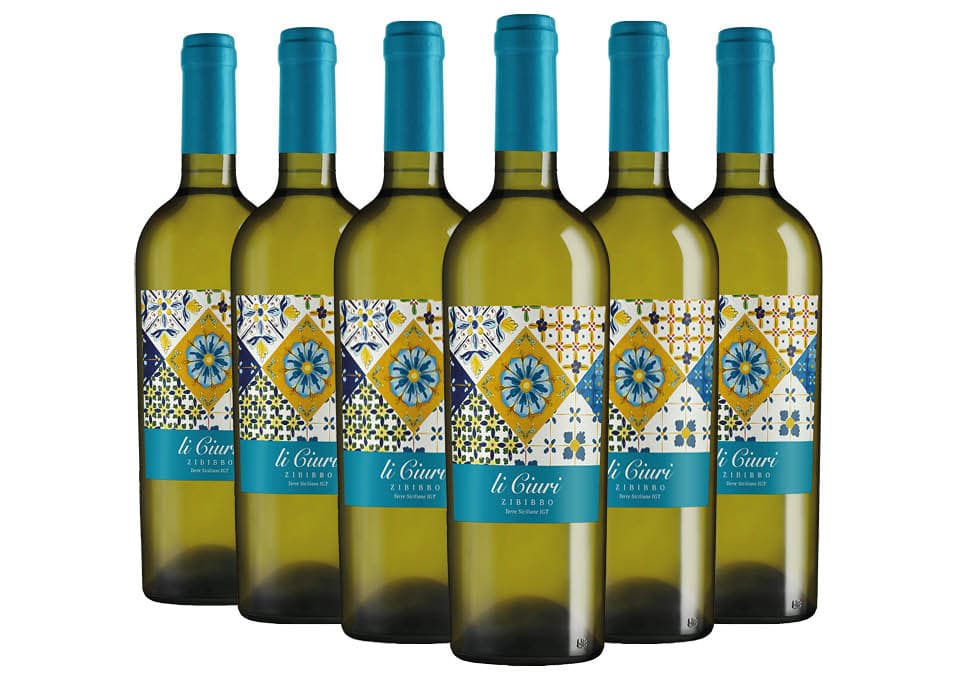Zibibbo, Sicily
The term zibibbo derives from the Arabic word zibibb , which meant dried grapes. In reality, the name of the grape variety is Muscat of Alexandria and, as the name implies, it comes from Egypt or more generally from the Middle East area. It is an ancient variety born from the cross between white muscat and an ancient Greek grape: eftakoilo or heptakilo. For centuries it has been cultivated in the western part of Sicily, in particular in the Trapani area and on the island of Pantelleria. It is a typically Mediterranean variety, which loves heat, wind, endures dry, dry climate and adapts very well to poor and stony soils, especially if of volcanic origin. It produces clusters with an elongated shape, with rather large berries with a thick skin covered with bloom. It is an aromatic grape with a sweet taste, which traditionally was used both as a table grape and for making wine. Precisely for its persuasive aromas, the zibibbo was mainly used to produce raisins or to make straw wines. Especially the island of Pantelleria, where zibibbo has always been grown almost exclusively, has become famous precisely for the production of extraordinary straw wines.
In recent decades, in the face of a progressive decline in the consumption of sweet wines, the production of dry wines with a very interesting and pleasant taste has increased. It is white that expresses an intense and elegant bouquet, with aromas of orange blossom, citrus fruits, ripe fruit, tropical hints, nuances of aromatic herbs of the Mediterranean scrub and iodine memories. The sip is soft and persuasive, with a juicy and wide mouth center, well balanced by a lively citrus freshness, which closes with pleasantly sapid sensations. It is a perfect white to taste with seafood appetizers or shellfish. Zibibbo Passito is a wine of great charm, with aromas of candied citrus peel, dried apricot, dehydrated fruit, almond, dried fruit, honey and spices. On the palate it is rich and sweet, with complex and persistent aromas, which anticipate a refreshing finish. It is an ideal dessert wine to accompany classic Sicilian sweets or dry pastries.
 Sicily is a happy island for wine: from the slopes of Etna to the coasts of Cerasuolo, to the small islands of Salina and Pantelleria, each area has its own grape variety and style, with wines so different that sometimes they seem to come from different continents, obtained both from native grapes such as Grillo, Carricante and Frappato, and from great international grapes that have found a small paradise on the island, such as Chardonnay. Viticulture in this region has ancient origins, suspended between the legend that tells of a thirsty Dionysus, from whose tears the first vine was born, and the history that documents the arrival of the Greeks, and before them even the Phoenicians, with the first rooted cuttings.
Sicily is a happy island for wine: from the slopes of Etna to the coasts of Cerasuolo, to the small islands of Salina and Pantelleria, each area has its own grape variety and style, with wines so different that sometimes they seem to come from different continents, obtained both from native grapes such as Grillo, Carricante and Frappato, and from great international grapes that have found a small paradise on the island, such as Chardonnay. Viticulture in this region has ancient origins, suspended between the legend that tells of a thirsty Dionysus, from whose tears the first vine was born, and the history that documents the arrival of the Greeks, and before them even the Phoenicians, with the first rooted cuttings.
Character and uniqueness of Sicilian red wines.
The slopes of Etna certainly represent one of the most suitable areas for viticulture in Sicily, with excellent results for Sicilian red wine, which here takes on an almost alpine elegance. Here the extreme conditions such as the volcanic soil, the slope of the land and the altitude of the vineyards make viticulture heroic and there are few indigenous grapes, such as Nerello Mascalese and Nerello Cappuccio. Sicily, however, has many other interesting appellations as regards red wines: in addition to Etna Doc we find in fact, next to the very small Doc Eloro, which preserves rare native grapes such as Perricone and Pignatello, the Contessa Entellina appellation, cradle of cult Sicilian reds, such as Mille e Una Notte, obtained from Nero d'Avola or from international Cabernet and Merlot grapes. Do not forget the Cerasuolo di Vittoria, in south-eastern Sicily, the only DOCG in the region and an admirable union of Nero d'Avola and Frappato.
Sicilian white wine: dry or sweet, it is however a masterpiece.
Carricante, Grillo, Chardonnay, Malvasia: Sicily is not only the home of great red wines but also of intense and fragrant whites and sweet wines to make you lose your mind. From the aromatic grapes of Chardonnay are born Sicilian white wines for aging in Doc Melfi and Alcamo, able to compete with the great wines of Burgundy, while Moscato, Zibibbo and Malvasia give life to fresh and exciting wines in Salina and on the Sicilian coasts, which become splendid sweet passito wines in Pantelleria, Lipari and Noto. The results of heroic viticulture on Etna are also exceptional, where the whites obtained from Carricante grapes stand out for their minerality and longevity. Last but not least, Marsala, born mainly from white grapes and historical wine of the island of Sicily.
What is the finest Sicilian wine?
It is difficult to answer this question, because Sicily has a wine production equal to that of Veneto and Tuscany, certainly we cannot fail to mention among the red wines the Mille e Una Notte by Donnafugata and the Harmonium by Firriato among the red wines and Planeta's Chardonnay among whites. However, there are other wineries that produce excellent wines such as Tasca d'Almerita and Duca di Salaparuta, Li Ciuri and Cusumano, Palmento Costanzo and Nicosia just to name a few. Finally, among the big names in sweet wines, we cannot forget the Marsala di Florio and the sweet wines of Donnafugata.
What is the oldest sweet Sicilian wine?
Marsala is undoubtedly one of the oldest sweet wines in Sicily: as early as 1832 Vincenzo Florio, a native of Bagnara Calabra, exported this sweet wine to over 99 countries around the world.
What is the best match for a white Sicilian wine?
The Sicilian white wines, with their characteristic intensity that unites them all, the minerality that characterizes those of Etna and the savory notes typical of those born on the islands are perfect in combination with all fish dishes rich in taste, from dishes with sardines up to pasta with swordfish, passing through fish soups and cous cous up to stuffed squid and sweet and sour tuna and aubergine caponata.


















